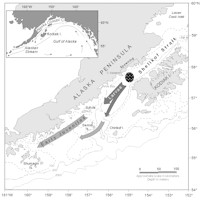
U.S. Dept. of Commerce / NOAA / OAR / PMEL / Publications
Plankton occur in aggregations or patches on a continuum of scales. These features are dynamic, continually responding to temporal and spatial changes in the physical processes that create, maintain and disperse them. The transport of phytoplankton by subtidal currents influences the degree of patchiness (Eppley et al., 1984). Tidal currents can deform the shape of larval patches (Levasseur et al., 1983), and internal tidal bores off southern California transport larvae shoreward (Pineda, 1991). Mesoscale physical features (e.g., fronts, eddies, and meanders) often create boundaries between water types associated with aggregations. For example, in the eastern Bering Sea, frontal systems result in distinct plankton and higher trophic level communities (Kinder et al., 1983; Smith and Vidal, 1986) and regions where zooplankton and their predators aggregate (Coyle and Cooney, 1993). Wind-driven flow and its interaction with topographic features influences the degree of patchiness found on the Great Barrier Reef (Willis and Oliver, 1990). In Shelikof Strait, fronts influence plankton distributions (Brodeur et al., 1996a, see pp. 71-80 in this supplement; Napp et al., 1996, see pp. 19-30 in this supplement) and high concentrations of larval pollock often are associated with eddies (Schumacher et al., 1993; Vastano et al., 1992). The dominant physical mechanisms that cause patches depend on the life style of the organism and the nature of the oceanography in the region.
We focus on the horizontal patterns (scales of tens of km) of the early life stages of walleye pollock (Theragra chalcogramma) in the western Gulf of Alaska (Fig. 1). Data from 38 ichthyoplankton surveys conducted on the shelf in and to the southwest of Shelikof Strait (1979-1992) provide the observations for this paper. Statistics of patchiness are examined using Lloyd's index (Lloyd, 1967), and an estimate of the percentage of larvae per survey in patches is made. Characteristics of larval patterns help to establish the physical processes that create and maintain the patches. As larvae develop, their improving ability to swim adds a behavioral aspect that can influence patch dynamics. This aspect is examined using an analytic model that balances effects of diffusion with swimming ability.
Figure 1. The study area in the western Gulf of Alaska with a schematic of pollock location as a function of life history stage. The sea valley extends southwestward from the northern end of Kodiak Island to the vicinity of Sutwik Island where it turns south toward the continental slope. The insert shows the location of the Alaska Coastal Current and the Alaskan Stream.
A large concentration of adult pollock aggregates each March over the deep sea valley to spawn (Fig. 1). Eggs are found in the bottom 50 m near the spawning location in early April; by late April or early May the eggs hatch and the larvae drift southwestward toward Sutwik Island (Hinckley et al., 1991; Kendall and Picquelle, 1990). Larvae are generally found in the upper 50 m (Kendall et al., 1994). Significant interannual differences in larval distribution and abundance occur by late May (Kendall and Picquelle, 1990; Hermann et al., 1996b, see pp. 58-70 in this supplement).
Circulation on the shelf in the North Pacific is dominated by the Alaska Coastal Current (ACC), a narrow (<50 km), shallow (<150 m) and partially baroclinic current that flows southwestward along the coast (Stabeno et al., 1995). The ACC occupies only a portion of the sea valley at any time and its strength fluctuates on a time scale of days. In Shelikof Strait, current speed (transport) can be appreciable, briefly reaching ~100 cm s-1 (3 × 106 m3 s-1). Transport is largely determined by winds, which are spatially complex (Macklin et al., 1993) and create zones of convergence in the Ekman layer (Schumacher and Kendall, 1991). Southwestward larval drift is characterized by two primary tracks, either the weak flow (<10 cm s-1) along the Alaska Peninsula shoreward of the sea valley, or in the rapidly moving (>25 cm s-1) ACC (Kim and Kendall, 1989).
Eddies are common in the sea valley to the west of Kodiak Island. For example, from April to July 1989, 10 eddies (2.5 month-1) were observed in the sea valley (Bograd et al., 1994). Results from a semi-spectral primitive equation model tuned to this region indicate that the number of eddies observed in 1989 was not unusual and was a function of freshwater discharge (Hermann and Stabeno, 1996; Stabeno and Hermann, 1996). The primary source of eddies is baroclinic instability, which occurs often within Shelikof Strait (Mysak et al., 1981; Schumacher et al., 1993).
Return to Abstract or go to next section